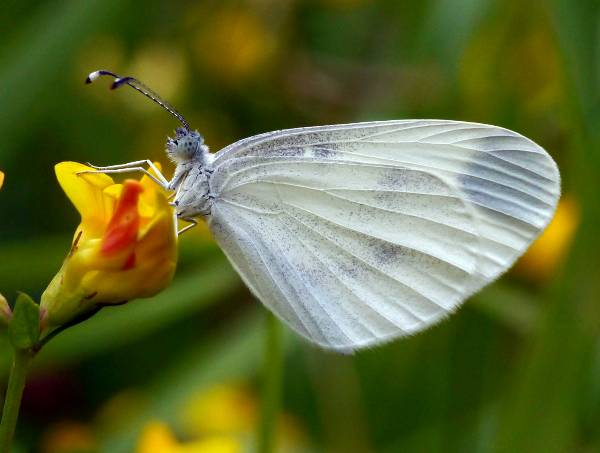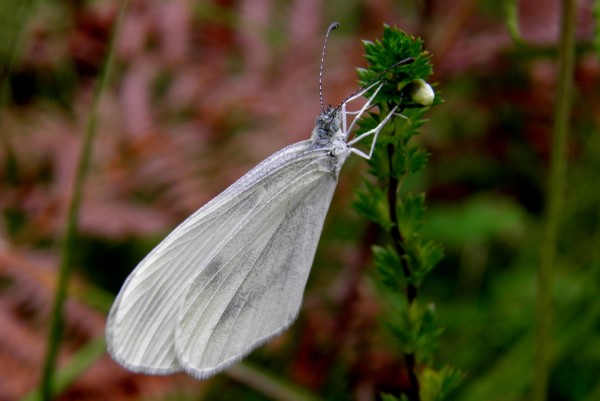Wood White Butterfly - Leptidea sinapis
Phylum: Arthropoda - Class: Insecta - Order: Lepidoptera - Family: Pieridae

Female (left) and male (right) Wood White butterflies
This delicate little butterfly gets its common name from just one of the habitats in which it can be found - woodland edges and clearings; however, it is certainly not confined to woods and can be found in a variety of rank grassland habitats as well as, in contrast, on sparsely-vegetated limestone pavement.

Description
The forewings of the Wood White have grey tips, darker in the males, while the creamy-white undersides of both forewings and hindwings have poorly-delineated grey veins. The wingspan of both males and females is typically 4.2cm, and the wings are noticeably more rounded than those of most other members of the Pieridae. These slow-flying butterflies always rest with their wings held in the closed position. It is the male who does most of the flying, constantly in search of a mate - or preferably several. The females, which are repored to be monogamous, feed on flowers and are less often seen flying.
Habitat
As well as shady woodland edges, rides and clearings, the Wood White can also be found in scrubby wasteland, unmanaged or fallow rank grasslands and some lowland limestone pavement areas - notably the Burren, in Ireland's County Clare and County Galway.
Distribution
The Wood White is an uncommon to rare sight in southern England and very rare further north; it is also found on the Burren in south-west Ireland. This butterfly is very rarely seen in Wales apart from along the southern Marches (the region bordering England) and it does not occur in Scotland. On the European mainland, Wood Whites have been recorded from southern Scandinavia through most of northern and central Europe and down to the Mediterranean, including the Iberian Peninsula. Its range extends eastwards to the Middle East and into parts of Asia.

Lifecycle
The larval foodplants used by the Wood White include various members of the pea family (Fabaceae), such as Meadow Vetchling Lathyrus pratensis, Tufted Vetch Vicia cracca, and Lesser Birds-foot Trefoil Lotus corniculatus. The lemon-yellow eggs, which are laid singly on the undersides of leaves, are spindle shaped and longitudinally ribbed; they take two to three weeks to hatch. The green caterpillars go through five instars before entering a long pupation through late autumn, winter and early spring.
In northern Europe the Wood White is univoltine (having a single brood), while in central Europe it is bivoltine with one brood in spring and a second brood in summer. At the southernmost part of its range this species is reported to be trivoltine.
Acknowledgements
This page includes pictures kindly contributed by Steve Jelf and by Betty and Tony Rackham.
Studying butterflies and moths...
Excited at the prospect of flyfishing? So are we, and we're pretty sure you would find the Winding River Mystery trilogy of action-packed thrillers gripping reading too. Dead Drift, Dead Cert, and Dead End are Pat O'Reilly's latest river-and-flyfishing based novels, and now they are available in ebook format. Full details on our website here...
Buy each book for just £4.96 on Amazon...
Please Help Us: If you have found this information interesting and useful, please consider helping to keep First Nature online by making a small donation towards the web hosting and internet costs.
Any donations over and above the essential running costs will help support the conservation work of Plantlife, the Rivers Trust and charitable botanic gardens - as do author royalties and publisher proceeds from books by Pat and Sue.
